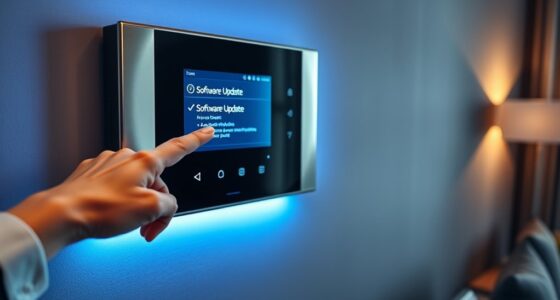To keep your smart devices secure and functioning well, you need to understand firmware updates. Firmware is the software directly controlling your device hardware, so updating it fixes bugs, closes security vulnerabilities, and boosts performance. Always watch for update notifications, prepare your device, and use official sources to avoid issues. Automating updates helps maintain security effortlessly. If you want to learn how to manage firmware updates smoothly, there’s more to explore below.
Key Takeaways
- Regularly check for and install firmware updates to fix bugs, improve performance, and patch security vulnerabilities.
- Ensure device compatibility and use official sources to prevent update failures or malfunctions.
- Enable automatic updates and verify update sources to maintain device security with minimal manual effort.
- Prepare devices by charging fully, backing up data, and connecting to stable networks before updating.
- Monitor device health and establish update schedules to sustain a secure, efficient smart device ecosystem.
Understanding Firmware and Its Role in Smart Devices

Have you ever wondered what makes your smart devices function smoothly? It all comes down to firmware, a specialized software that controls hardware components like processors, sensors, and memory. Firmware acts as the bridge between your device’s hardware and its user interface, ensuring everything responds correctly and operates efficiently. Without it, your device wouldn’t be able to perform tasks or communicate with apps. Think of firmware as the internal brain that keeps everything running behind the scenes. It’s embedded directly into the device’s hardware, making updates vital for fixing bugs, improving performance, and adding features. A well-maintained firmware also ensures hardware compatibility and optimal functionality. By understanding firmware’s role, you get a clearer picture of why keeping it updated helps your smart device stay secure and functional.
Why Firmware Updates Are Crucial for Security and Performance

Keeping your firmware updated is essential to patch security vulnerabilities that could be exploited by hackers. Updates also improve device performance and add new features, making your devices run smoother. By staying current, you reduce the risk of security breaches and guarantee your devices work their best. Additionally, timely updates can prevent potential cybersecurity vulnerabilities from being exploited during events like global outages.
Patch Vulnerability Risks
Since firmware vulnerabilities can be exploited by cybercriminals to gain unauthorized access or disrupt device functions, applying timely updates is essential to protect your systems. However, vulnerability patching isn’t without its risks. Sometimes, updates can introduce new bugs or compatibility issues, creating update risks that might temporarily impair device performance. These potential problems can make you hesitant to apply patches immediately. Still, ignoring firmware updates leaves your devices open to security breaches. To minimize these risks, make sure you follow best practices, such as backing up your device before updating and verifying update sources. Understanding that the benefits of patching outweigh the temporary inconvenience helps you stay proactive, keeping your devices secure and resilient against emerging threats. Regularly updating firmware also ensures that your air purifier features and technology remain effective and up-to-date.
Enhance Device Functionality
Regular firmware updates are essential because they not only fix security vulnerabilities but also improve your device’s overall performance. They often introduce new features, giving you more options for device customization to better suit your needs. Updated firmware can enhance stability, speed, and responsiveness, making your device run smoother and more efficiently. Additionally, firmware updates sometimes include a firmware rollback feature, allowing you to revert to a previous version if new updates cause issues. This flexibility ensures you can enjoy improved functionality without risking device stability. Keeping your firmware current guarantees you get the most out of your device’s capabilities, making it more versatile and reliable for daily use. Moreover, staying updated helps protect against emerging security vulnerabilities, ensuring your device remains safeguarded. Regular updates truly maximize your device’s potential while maintaining ideal security.
Prevent Security Breaches
Updating your device’s firmware isn’t just about adding new features; it’s an essential step in safeguarding your information. Regular updates improve IoT encryption, making it harder for hackers to intercept or compromise your data. Firmware patches often fix vulnerabilities that could be exploited to breach your device’s security. If an update causes issues, a firmware rollback option allows you to revert to a previous, stable version, reducing downtime and preventing potential security gaps. Ignoring updates leaves your device vulnerable to cyberattacks and malware that can steal personal information or disrupt functionality. Staying current with firmware updates ensures your device benefits from the latest security enhancements, protecting both your data and your network’s integrity. Maximize security and organization by keeping firmware current. Don’t skip updates—they’re key to preventing security breaches.
Recognizing When Your Devices Need an Update

Devices usually need updates when you notice they start acting sluggish, freeze, or display error messages more often. These signs often indicate that your device’s firmware is outdated and may no longer be functioning efficiently. Paying attention to update notifications is key—they appear when manufacturers release patches or improvements as part of the firmware lifecycle. These alerts are your cue to check whether your device requires an update. Ignoring them can leave your device vulnerable or cause performance issues. Regularly monitoring for notifications ensures you stay ahead of potential problems. If you notice unusual behavior or receive prompts, it’s a clear sign that your device needs a firmware update to maintain security, stability, and performance. Additionally, staying informed about automation in business can help you understand how technological advancements impact device management and updates. Recognizing these signs helps keep your devices running smoothly.
Step-by-Step Guide to Installing Firmware Updates Safely

To guarantee a smooth and safe firmware update, start by preparing your device and environment. Ensure your device is fully charged or plugged in, and back up important data. Connect to a stable Wi-Fi network to prevent interruptions. Before updating, check for firmware troubleshooting tips in case issues arise. During installation, avoid using the device to maintain proper device synchronization. Additionally, staying informed about security updates can help protect your device from vulnerabilities.
Common Challenges and How to Overcome Them

Firmware updates can present challenges like device compatibility issues, download problems, and security risks. Recognizing these hurdles helps you prepare and avoid potential setbacks. Let’s explore common obstacles and simple ways to overcome them effectively. Regular updates on payment technology can enhance user experience and security, ensuring your devices stay protected against emerging threats.
Device Compatibility Issues
Compatibility issues often arise when updating firmware, especially if your device isn’t designed to support the latest version. These device compatibility problems can lead to firmware conflicts, causing your device to malfunction or become unresponsive. To avoid this, check your device’s specifications and the firmware update requirements before proceeding. Make sure the update is compatible with your device model and hardware version. If you encounter a compatibility warning, consider waiting for an official update tailored for your device or contacting support for guidance. Sometimes, manufacturers release interim patches or older firmware versions to address compatibility issues. Being proactive and verifying device compatibility helps ensure a smooth update process and prevents potential device failures caused by firmware conflicts.
Firmware Download Difficulties
Downloading firmware can sometimes be challenging due to slow internet connections, server issues, or restrictions imposed by firewalls and security settings. These obstacles can interrupt your firmware download, leading to incomplete or corrupted files. Making certain that update compatibility is vital; if the firmware isn’t compatible with your device model or current software version, the download may fail or cause errors. To overcome these issues, check your internet speed, temporarily disable firewalls if necessary, and verify that you’re downloading the correct firmware for your device. Using a wired connection can also improve stability. Always download firmware from official sources to avoid corrupted or malicious files. Taking these steps helps make certain of a smooth firmware download process, reducing frustration and making sure your device stays up to date. Additionally, consulting Firmware Download Difficulties resources can provide tailored solutions for specific issues you might encounter.
Security Concerns and Risks
While ensuring a smooth download process is important, safeguarding your device from security threats during firmware updates is equally essential. IoT vulnerabilities, if left unaddressed, can expose your network to hackers. Firmware encryption helps protect update files from tampering, but not all devices implement it effectively. Common challenges include insecure update channels and outdated firmware, increasing risks. To mitigate these, always verify update sources and enable automatic updates when possible.
| Challenge | Risk | Solution |
|---|---|---|
| IoT vulnerabilities | Unauthorized access or control | Regularly update firmware |
| Unencrypted updates | Data interception or tampering | Use firmware encryption |
| Outdated firmware | Exploitable security flaws | Enable automatic updates |
| Insecure channels | Man-in-the-middle attacks | Verify update source |
Automating Firmware Updates for Peace of Mind

Automating firmware updates can substantially reduce the risk of security vulnerabilities and system malfunctions, giving you peace of mind. With automation, your devices stay current without manual effort, ensuring patches are applied promptly. Many systems offer firmware customization options, allowing you to tailor updates to your specific needs or preferences. Additionally, implementing firmware rollback features provides a safety net, enabling you to revert to a previous version if an update causes issues. This combination of automation, customization, and rollback capabilities helps maintain stability and security effortlessly. By setting up automatic updates, you minimize the chances of overlooking essential patches and keep your smart devices protected against evolving threats. Ultimately, automation simplifies maintenance, keeping your ecosystem reliable and secure without constant oversight.
Best Practices for Maintaining a Secure and Efficient Smart Ecosystem

To maintain a secure and efficient smart ecosystem, you need to implement best practices that protect your devices and enhance performance. Regularly monitor your device lifecycle, replacing outdated hardware before vulnerabilities arise. Establish an update frequency schedule—whether weekly or monthly—to ensure firmware stays current, reducing security risks. Prioritize automatic updates when possible, but review device-specific settings to avoid disruptions. Use the following table to guide your approach:
| Practice | Benefit |
|---|---|
| Schedule regular updates | Keeps firmware secure and improves stability |
| Replace aging devices | Prevents vulnerabilities linked to outdated hardware |
| Monitor device health | Ensures optimal performance and security |
Frequently Asked Questions
Can Firmware Updates Cause Device Malfunctions or Data Loss?
Firmware updates can sometimes cause device malfunctions or data loss, mainly due to manufacturer risks like bugs in the new firmware or update compatibility issues. When you update, there’s a chance that hardware or software conflicts may arise, leading to problems. To minimize these risks, make certain your device is compatible with the update and follow proper procedures, like backing up data, before applying any firmware updates.
How Often Should I Check for Firmware Updates?
You should check for firmware updates as often as you’d refresh a mountain stream—frequently and promptly. The ideal update frequency depends on your device and its usage, but generally, review update scheduling once a month. Regular checks guarantee you get security patches and new features without risking device malfunctions. Staying proactive keeps your smart devices running smoothly and protects your data from potential vulnerabilities.
Are Firmware Updates Necessary for All Smart Devices?
You might wonder if firmware updates are necessary for all your smart devices. While not every device needs constant updates, keeping firmware current guarantees better software compatibility and security. Check update frequency recommendations, as some devices require regular updates to patch vulnerabilities or improve performance. Skipping updates can leave your devices exposed, so stay informed and update when prompted to keep everything running smoothly and securely.
What Should I Do if a Firmware Update Fails?
If a firmware update fails, don’t panic. First, verify the update’s source and guarantee your device is connected properly. Check for update verification steps in the device manual or app. It’s also wise to back up your device before attempting another update. If problems persist, contact support or consult online forums. These backup precautions and verification steps help prevent data loss and ensure a smoother update process.
Do I Need Technical Skills to Perform Firmware Updates Safely?
You don’t need extensive technical knowledge to perform firmware updates safely. Basic troubleshooting skills and following clear instructions are usually enough. Many devices have user-friendly update processes that guide you through each step, reducing the risk of errors. If you encounter issues, troubleshooting skills help you resolve common problems, ensuring your device stays secure and up-to-date without needing advanced technical expertise.
Conclusion
Think of your smart devices as a well-tended garden, thriving only with regular care. By keeping firmware updated, you’re watering and nourishing them, ensuring they stay secure and sprout new features. With each update, you’re clearing out weeds of vulnerabilities and planting seeds for smoother performance. Stay vigilant and proactive—your connected home will flourish, safe and vibrant, like a lush landscape thriving under your attentive watch.









